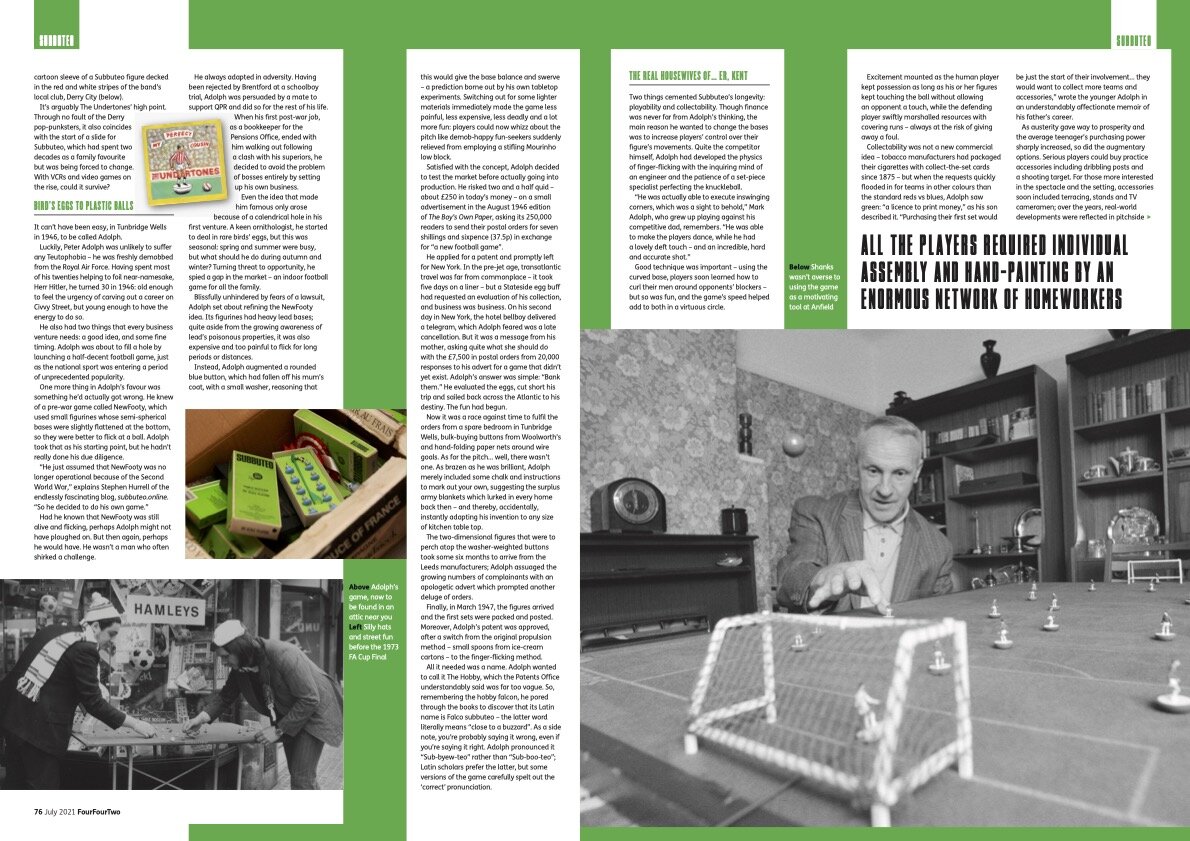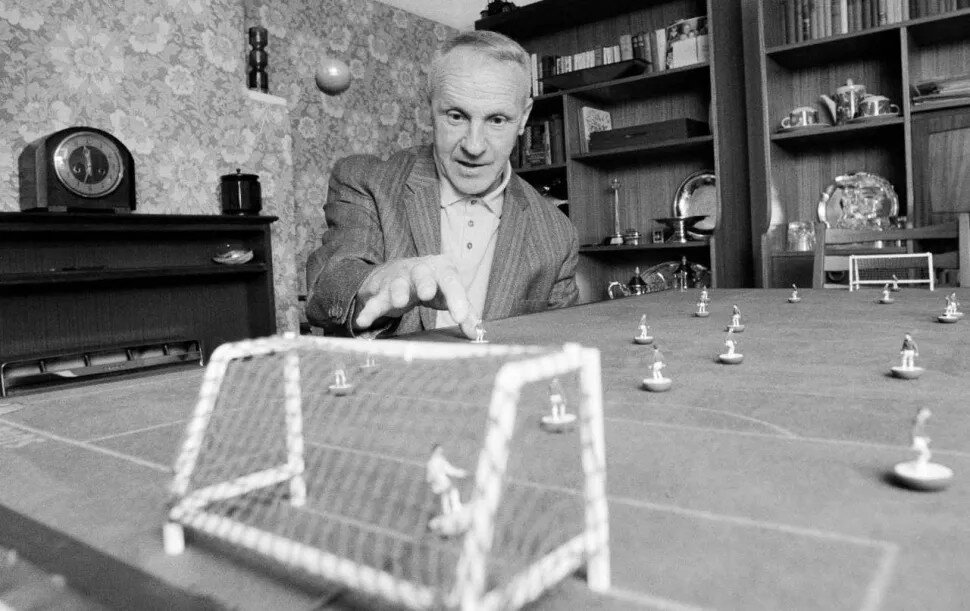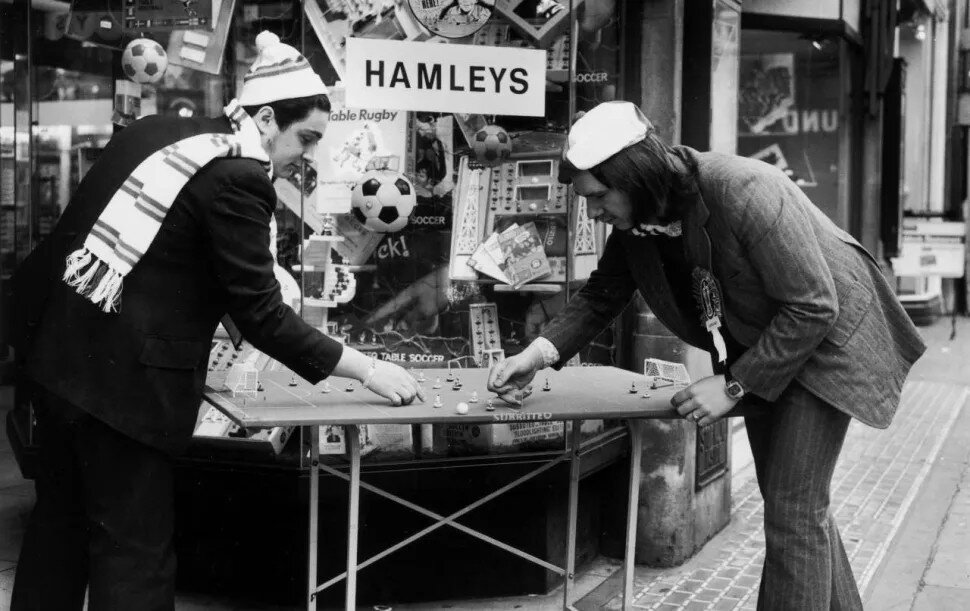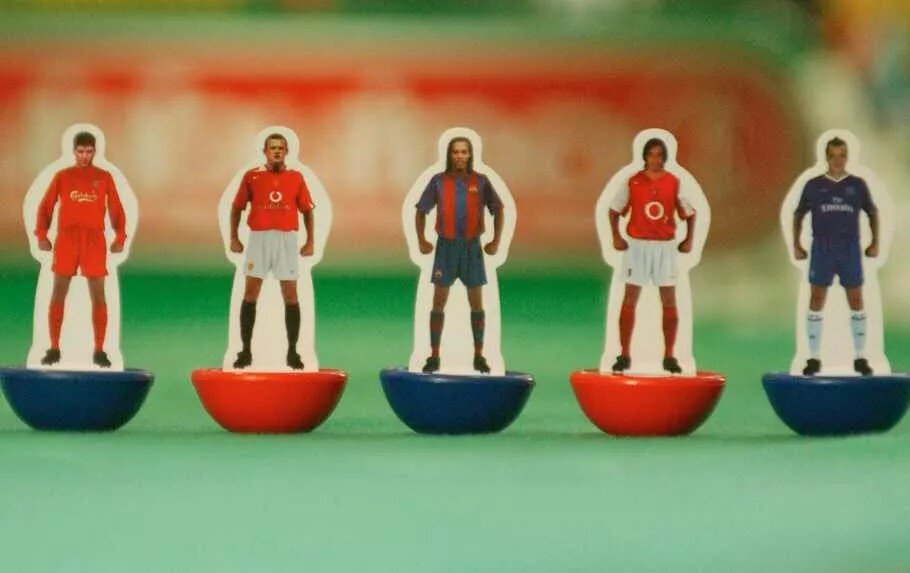Teenage Flicks: The Subbuteo story
It’s a scene that couldn’t be more 1979 if it were Alan Sunderland’s perm voting Margaret Thatcher into power. While a bulbous cathode-ray TV screen flickers in its wooden cabinet in the background, five young men are crowded around their domestic table, animatedly flicking figures across a green cloth.
One of the lads then turns to the camera and sings, “He always beat me at Subbuteo, cos he flicked to kick and I didn’t know.” These young chaps are Northern Irish punk band The Undertones, and this is the video to their new single, My Perfect Cousin, which they hope will build on the momentum gained from Teenage Kicks, Jimmy Jimmy and Here Comes The Summer.
In the event, it does better than that. Although Teenage Kicks goes on to be John Peel’s favourite song ever and a must-play for every terrible wedding band, My Perfect Cousin becomes The Undertones’ sole top-10 hit. In an era of huge record sales – 1979 was the UK singles charts’ pre-digital peak, with 79 million singles flogged – tens of thousands of kids buy the single, with its cartoon sleeve of a Subbuteo figure decked in the red and white stripes of the band’s local club, Derry City.
It’s arguably The Undertones’ high point. Through no fault of the Derry pop-punksters, it also coincides with the start of a slide for Subbuteo, which had spent two decades as a family favourite but was being forced to change. With VCRs and video games on the rise, could it survive?
From birds’ eggs to plastic balls
It can’t have been easy, in Tunbridge Wells in 1946, to be called Adolph.
Luckily, Peter Adolph was unlikely to suffer any Teutophobia – he was freshly demobbed from the Royal Air Force. Having spent most of his twenties helping to foil near-namesake, Herr Hitler, he turned 30 in 1946: old enough to feel the urgency of carving out a career on Civvy Street, but young enough to have the energy to do so.
He also had two things that every business venture needs: a good idea, and some fine timing. Adolph was about to fill a hole by launching a half-decent football game, just as the national sport was entering a period of unprecedented popularity.
One more thing in Adolph’s favour was something he’d actually got wrong. He knew of a pre-war game called NewFooty, which used small figurines whose semi-spherical bases were slightly flattened at the bottom, so they were better to flick at a ball. Adolph took that as his starting point, but he hadn’t really done his due diligence.
“He just assumed that NewFooty was no longer operational because of the Second World War,” explains Stephen Hurrell of the endlessly fascinating blog, subbuteo.online. “So he decided to do his own game.”
Had he known that NewFooty was still alive and flicking, perhaps Adolph might not have ploughed on. But then again, perhaps he would have. He wasn’t a man who often shirked a challenge.
He always adapted in adversity. Having been rejected by Brentford at a schoolboy trial, Adolph was persuaded by a mate to support QPR and did so for the rest of his life. When his first post-war job, as a bookkeeper for the Pensions Office, ended with him walking out following a clash with his superiors, he decided to avoid the problem of bosses entirely by setting up his own business.
Even the idea that made him famous only arose because of a calendrical hole in his first venture. A keen ornithologist, he started to deal in rare birds’ eggs, but this was seasonal: spring and summer were busy, so what should he do during autumn and winter? Turning threat to opportunity, he spied a gap in the market – an indoor football game for all the family.
Blissfully unhindered by fears of a lawsuit, Adolph set about refining the NewFooty idea. Its figurines had heavy lead bases; quite aside from the growing awareness of lead’s poisonous properties, it was also expensive and too painful to flick for long periods or distances.
Instead, Adolph augmented a rounded blue button, which had fallen off his mum’s coat, with a small washer, reasoning that this would give the base balance and swerve – a prediction borne out by his own tabletop experiments. Switching out for some lighter materials immediately made the game less painful, less expensive, less deadly and a lot more fun: players could now whizz about the pitch like demob-happy fun-seekers suddenly relieved from employing a stifling Mourinho low block.
Satisfied with the concept, Adolph decided to test the market before actually going into production. He risked two and a half quid – about £250 in today’s money – on a small advertisement in the August 1946 edition of The Boy’s Own Paper, asking its 250,000 readers to send their postal orders for seven shillings and sixpence (37.5p) in exchange for “a new football game”.
He applied for a patent and promptly left for New York. In the pre-jet age, transatlantic travel was far from commonplace – it took five days on a liner – but a Stateside egg buff had requested an evaluation of his collection, and business was business. On his second day in New York, the hotel bellboy delivered a telegram, which Adolph feared was a late cancellation. But it was a message from his mother, asking quite what she should do with the £7,500 in postal orders from 20,000 responses to his advert for a game that didn’t yet exist. Adolph’s answer was simple: “Bank them.” He evaluated the eggs, cut short his trip and sailed back across the Atlantic to his destiny. The fun had begun.
Now it was a race against time to fulfil the orders from a spare bedroom in Tunbridge Wells, bulk-buying buttons from Woolworth’s and hand-folding paper nets around wire goals. As for the pitch… well, there wasn’t one. As brazen as he was brilliant, Adolph merely included some chalk and instructions to mark out your own, suggesting the surplus army blankets which lurked in every home back then – and thereby, accidentally, instantly adapting his invention to any size of kitchen table top.
The two-dimensional figures that were to perch atop the washer-weighted buttons took some six months to arrive from the Leeds manufacturers; Adolph assuaged the growing numbers of complainants with an apologetic advert which prompted another deluge of orders.
Finally, in March 1947, the figures arrived and the first sets were packed and posted. Moreover, Adolph’s patent was approved, after a switch from the original propulsion method – small spoons from ice-cream cartons – to the finger-flicking method.
All it needed was a name. Adolph wanted to call it The Hobby, which the Patents Office understandably said was far too vague. So, remembering the hobby falcon, he pored through the books to discover that its Latin name is Falco subbuteo – the latter word literally means “close to a buzzard”. As a side note, you’re probably saying it wrong, even if you’re saying it right. Adolph pronounced it “Sub-byew-teo” rather than “Sub-boo-teo”; Latin scholars prefer the latter, but some versions of the game carefully spelt out the ‘correct’ pronunciation.
The real housewives of Kent
Two things cemented Subbuteo’s longevity: playability and collectability. Though finance was never far from Adolph’s thinking, the main reason he wanted to change the bases was to increase players’ control over their figure’s movements. Quite the competitor himself, Adolph had developed the physics of finger-flicking with the inquiring mind of an engineer and the patience of a set-piece specialist perfecting the knuckleball.
“He was actually able to execute inswinging corners, which was a sight to behold,” Mark Adolph, who grew up playing against his competitive dad, remembers. “He was able to make the players dance, while he had a lovely deft touch – and an incredible, hard and accurate shot.”
Good technique was important – using the curved base, players soon learned how to curl their men around opponents’ blockers – but so was fun, and the game’s speed helped add to both in a virtuous circle.
Excitement mounted as the human player kept possession as long as his or her figures kept touching the ball without allowing an opponent a touch, while the defending player swiftly marshalled resources with covering runs – always at the risk of giving away a foul.
Collectability was not a new commercial idea – tobacco manufacturers had packaged their cigarettes with collect-the-set cards since 1875 – but when the requests quickly flooded in for teams in other colours than the standard reds vs blues, Adolph saw green: “a licence to print money,” as his son described it. “Purchasing their first set would be just the start of their involvement… they would want to collect more teams and accessories,” wrote the younger Adolph in an understandably affectionate memoir of his father’s career.
As austerity gave way to prosperity and the average teenager’s purchasing power sharply increased, so did the augmentary options. Serious players could buy practice accessories including dribbling posts and a shooting target. For those more interested in the spectacle and the setting, accessories soon included terracing, stands and TV cameramen; over the years, real-world developments were reflected in pitchside adverts, floodlights, policemen, anti-hooligan fencing and even streaker figures. All quite realistic considering that the players were, in relative terms, glued to a five-foot coat button while chasing a six-foot ball.
After the initial home-made run, the base moulding was done at a local factory; when the owner decided to retire, Adolph bought him out – and when he realised that the underused moulding machines’ downtime cost money, our hero once again turned lemons into lemonade. Using his contacts, he won contracts to mould the figures for Scalextric cars, Hornby train sets and Dinky Toys – and then, at the turn of the 1960s, came the idea that supercharged Subbuteo.
The ‘players’ were still two-dimensional cardboard cutouts, affectionately known as ‘flats’. But with Adolph’s machines churning out little 3D fellas for other companies, why not do the same for Subbuteo players?
There were risks involved in what was to be marketed as the Continental range. The 3D players were far more labour-intensive to produce, requiring individual assembly and hand-painting by what became an enormous – and ultimately controversial – network of homeworkers, who were each paid £1.50 for every thousand figures.
“About half the mums in Kent were happy to work for us and earn a little ‘pin money’,” recalled former Subbuteo salesman David Morrison-Wilpred in an interview with the superbly-named Subbuteo collectors’ title Flick Me Sideways.
Despite initial misgivings and subsequent refinements, the ‘00-scale’ players proved immensely popular and prompted a golden era in the 1960s: there were even official Beatles Subbuteo figures (disappointingly, though, on flat bases). Having the 1966 World Cup hosted by England didn’t hurt either, with the game’s first ever TV advert and various members of the victorious home squad offering to endorse the product.
Adolph rebuffed those approaches but Subbuteo still loomed large (or rather, small) for real-life footballers. Bill Shankly deployed a set for tactics and team talks; there’s a story – perhaps apocryphal, this being Shankly, but equally possible, this being Shankly – that before Liverpool hosted Manchester United, he strode around the tabletop flicking opponents off the pitch, decrying them as unfit or useless. Eventually, only George Best and two others remained, at which point Shankly noted that if his team couldn’t beat three players, they shouldn’t be playing football. Such man-management style might belong to a different era, but the Subbuteo pitch remains: Man City use them as tactics boards at all levels, including Pep Guardiola’s first team, as do England all the way up to Gareth Southgate’s seniors.
In 1969, Waddingtons, the Leeds-based board-game giant responsible for Monopoly, Cluedo and other family favourites, offered to buy out Subbuteo. Adolph countered with a 35 per cent stake, but like that rapacious teenage market, they wanted the lot.
After agonising over it, he finally accepted £250,000 – around £4m in today’s terms. Son Mark would describe it as his naturally bullish father’s “only regret”. The inventor was kept on as brand director, but quickly bristled against the corporate culture and walked away – only returning to cheekily offer Waddingtons a Subbuteo clone, receiving nothing but an injunction.
Dick and Dent in da World Cup
Waddingtons held a 1970 Subbuteo World Cup at London’s Savoy Hotel, but the next one in Munich four years later was much bigger: England’s representative Michael Dent was interviewed by Radio 4 before playing the final against the Netherlands’ Dick Rietveld, during which crowds gathered outside the window of Hamleys toy shop in London to follow the action (Dent nudged ahead in the last minute, only for Rietveld to equalise and win it in extra time).
Expanding Subbuteo into the European market, Waddingtons found a particularly fervent market in Italy – even if the Azzurri contingent at the 1974 World Cup walked out over refereeing decisions. “The Italians absolutely love Subbuteo,” Stephen Hurrell told the Outside Write podcast. “The game is still huge there; it’s played in stadiums on matchdays, it’s on mainstream television.”
It also gets into the blood: ask Paolo Di Canio, born in Rome in 1968 and brought up playing the game.
“When I was young, I would play Subbuteo with my friend,” he says. “There was a squad with horizontal green and white lines – I was captivated by the colours. I decided that if one day I became a footballer, I would like to play in Scotland. After 10 years playing in Italy, an offer came from Glasgow. The first time I wore the Celtic shirt was emotional for me – I was like a child who has just received a big present.”
By that time, the pieceworking housewives of Kent were a blur of fingers and brushes: there have now been more than 700 different colourways produced – often at short notice and in great number.
“If a team like Watford, playing in a fairly unusual kit colour, knocked out a Manchester United or an Arsenal or a Liverpool, suddenly this massive demand came in for a team that they did offer in catalogues, but didn’t actually produce a lot of,” explained Hurrell. “So that meant they had to send thousands of figures away to local households to paint them up quickly and get them out onto the shop floors.”
For most of the ’60s and ’70s, Subbuteo were knocking out 300,000 miniature teams a year – millions of button-bottomed figures. The template was also extended into rugby, cricket and hockey (“for girls”), even if speedway, snooker and angling (yes, really) were somehow less successful. But a tabloid scandal was brewing – and it would change Subbuteo forever.
In the late 1970s, a Sunday newspaper splashed on a damning article claiming that Subbuteo’s homeworkers were paid “slave labour wages”. It was a typical tabloid exaggeration – nobody was forced to take the work – but the recently established Low Pay Unit became involved and Subbuteo suddenly decided to do what bosses have done for centuries when faced with rising wages: mechanise.
The new figures were universally derided as “zombies” for their lifeless features, and sent designers back to the drawing board.
In early 1980, as The Undertones and their cousin-baiting ditty played out in bedrooms across the nation, Subbuteo were producing another type of player – quickly nicknamed the “lightweight”.
While the new figures started to fall from grace with a general public fascinated by the burgeoning video game market, they found approval among one Subbuteo sector: the competitive player. As with the real game, the 1982 World Cup belonged to the Italians, who craftily polished their players’ bases to whizz them around the pitch.
Renzo Frignani lifted the trophy, but the man he’d hammered 7-2 in the final – Swiss champion Willy Hofmann – refined the idea to a science. Realising the polished figures could make lung-bursting runs – or at least the Subbuteo equal – Hofmann perfected a Klopp-esque system of devastating counter-attacks to win the 1986 World Cup.
A year later, a 16-year-old British prodigy called Justin Finch made the front pages by insuring his right hand for £160,000 – but by then, the marketing was starting to feel gimmicky. The last major Subbuteo World Cup was back in 1990; it was broadcast by Channel Four, and in an idle moment, you could do worse than Stephen Hurrell’s suggestion of checking it out on YouTube: “It’s absolutely crazy – people nearly come to blows over games, the crowd are booing players... it’s pantomime stuff.”
Even as it waned in popularity, Subbuteo inspired depths of devotion. Gianluigi Buffon, born in Tuscany in 1978, was given a Borussia Monchengladbach team as a boy and has carried a candle for the Prussians ever since.
“I’m not a fan, but it’s a team that I’ve always followed with pleasure,” gurgled Gigi. “When I was little it was one of the teams I always played with in my Subbuteo. I liked it because it had beautiful colours and a name I couldn’t pronounce.” Word is that Buffon now owns 500 Subbuteo teams.
Not every future star was as contented with the contents. Ashley Williams, born in Wolverhampton in 1984, raised a question that had troubled Subbuteo: “I asked my mum why there were no black players in my England teams,” he recalled. “There was no John Barnes or Des Walker and I wanted to know why. My mum thought it was a good question, so we sent in a letter. I didn’t stand on a mountain shouting about it, I was just a kid asking a question – but they changed it: they introduced black players.”
Spice up your life
Such an active response to a customer query would have delighted Peter Adolph, but his time was almost up – as was the company who had bought him out. Adolph died in 1994; Waddingtons sent a three-foot floral wreath in the shape of a Subbuteo player in QPR kit. On his headstone is an engraving of the hobby falcon, Falco subbuteo.
In that same year, Waddingtons sold its games division to US giant Hasbro. Acquiring Premier League licences promised something of a rebirth, but declining build quality in a computer-crammed competitive market meant Subbuteo was out on its plastic feet. In 2000, Hasbro announced that production would cease, blaming “the huge number of football-related products” that had “flooded the market”: the scarcity that had once been a boon to Adolph’s original game was now but a distant memory.
In 2005, history folded back on itself when Hasbro tried a relaunch with the 3D players replaced by 2D photographs, not unlike the original ‘flats’... except they were individual players. It flopped: there wasn’t the demand for flicking Roy Keane into Patrick Vieira.
So that’s it then, right? Not quite. Occupying its own cosy corner of retro sentimentality, Subbuteo has remained a cultural touchstone down the decades. The Undertones weren’t the only band to namecheck it; in 1986, Half Man Half Biscuit frontman and football’s poet laureate, Nigel Blackwell, penned the classic All I Want For Christmas Is A Dukla Prague Away Kit, in which the narrator is once again comprehensively beaten by a cousin-Kevinalike. Those defeats sting.
In 1997, Subbuteo hit the silver screen – twice. Besides the screen version of Nick Hornby’s Fever Pitch, it also turned up in the Spice Girls movie Spice World – even if, as Stephen Hurrell ruefully notes, “Mel C broke many Subbuteo rules when she scored”.
Ten years later, Lee Mack’s sitcom Not Going Out included an entire episode around a thwarted attempt to recreate the 1986 World Cup Final – the one won by Argentina, not Willy Hofmann – and two years later, Subbuteo popped up in Gavin and Stacey thanks to Uncle Bryn.
Still it goes on. The 2020 Red Dwarf reboot featured Lister hoarding a Subbuteo Partick Thistle away team, reasoning that “someone would kill for it”. And indeed they might, for the retro/vintage boom – and the internet’s niche-friendly nature – is keeping Subbuteo bubbling along nicely.
These days it’s mainly about collectors and enthusiasts rather than the mass market, but there are promising signs. A Hong Kong company has been licensed to produce new official Subbuteo goods, and thanks to some bedroom geniuses with 3D printers, you can now get a rubber-backed and therefore wrinkle-free pitch, a faux-muddy ‘winter’ pitch, a VAR screen for those controversial decisions, and even floodlights that work properly. In March 2021, history was made with the first all-female Subbuteo team, for the England Lionesses.
Peter Adolph might have aimed his original product at teenage boys, but he would have been delighted to accommodate girls – not to mention grown men and women. He did, after all, intend to create a game for all the family. And, as his son Mark has commented, “I feel privileged that Subbuteo is still in people’s consciousness.”
And presumably, still irking cousins somewhere.
Originally published by FourFourTwo in the July 2021 issue and FourFourTwo online 16 August 2021













